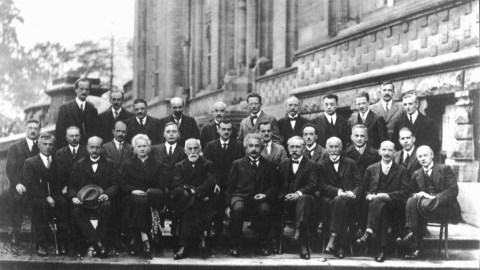Landau Genius Scale ranking of the smartest physicists ever

Photo by: Photo12/Universal Images Group via Getty Images
- Nobel-Prize-winning Soviet physicist Lev Landau used a scale to rank the best physicists of the 20th century.
- The physicist based it on their level of contribution to science.
- The scale was logarithmic, with each level being 10 times more valuable.
Lev Landau (1908-1968) was one of Soviet Union’s best physicists. He made contributions to nuclear theory, quantum field theory, and astrophysics, among others. In 1962, he won a Nobel Prize in Physics for developing the mathematical theory of superfluidity. Landau also wrote an immensely influential textbook on physics, teaching generations of scientists.
A brilliant mind, Landau liked to classify everything in his life. He ranked people by their intelligence, beauty (he had a penchant for blondes), contributions to science, how they dressed, and even how they talked – often with a healthy dose of sarcasm.
One of the most famous of Landau’s classifications that has been passed down is his ranking of the greatest physicists of the 20th century. Of course, it wouldn’t have later physicists, as he died in 1968, but these are arguably the most significant names.
This scale is logarithmic, meaning people ranked as rank 1 contributed ten times more (according to Landau) than people ranked as class 2, and so forth. In other words, the higher the number, the less valuable the physicist.
Here’s how this scale broke down:
Rank 0.5 – Albert Einstein (1879 – 1955)
Einstein, the creator of the Theory of General Relativity, is in a class of his own. Landau thought he was by far the greatest mind among a very impressive group that redefined modern physics.
Landau added, however, that if the list was to be expanded to scientists of the previous centuries, Isaac Newton (1643 – 1727), the titan of classical physics, would also join Einstein at first place with 0.5.

Albert Einstein With Displaced Children From Concentration Camps. 1949.Photo by Keystone-France/Gamma-Keystone via Getty Images
The group in this class of the smartest physicists included the top minds that developed the theories of quantum mechanics.
Werner Heisenberg (1901 – 1976) – a German theoretical physicist, who’s achieved pop-culture fame by being the name of Walter White’s alter ego in Breaking Bad. He is known for the Heiseinberg Uncertainty Principle and his 1932 Nobel Prize award flatly states it was for nothing less than “the creation of quantum mechanics”.
Erwin Schrödinger (1887 – 1961) – an Austrian-Irish physicist who gave us the infamous “Schroedinger’s Cat” thought experiment and other mind-benders from quantum mechanics. The Nobel-prize-winner’s Schrödinger equation calculates the wave function of a system and how it changes over time.

Erwin Schrödinger. 1933.
Paul Dirac (1902 – 1984) – another quantum mechanics giant, this English theoretical physicist shared the 1933 Nobel Prize with Erwin Schrödinger “for the discovery of new productive forms of atomic theory.”
Niels Bohr (1885 – 1962) – a Danish physicist who made founder-level additions to what we know of atomic structure and quantum theory, which led to his 1922 Nobel Prize in Physics.
Satyendra Nath Bose (1894 – 1974) – an Indian mathematician and physicist, known for his quantum mechanics work. He collaborated with Einstein to develop the Bose-Einstein statistics and the theory of the Bose–Einstein condensate. Boson particles are named after him.

Satyendra Nath Bose. 1930s.
Eugene Wigner (1902 – 1995) – a Hungarian-American theoretical physicist who received the 1963 Nobel Prize in Physics for work on the theory of the atomic nucleus and the elementary particles. Famously, he took part in the meeting with Leo Szilard and Albert Einstein that led to them writing a letter to President Franklin D. Roosevelt which resulted in the creation of the Manhattan Project.
Louis de Broglie (1892 – 1987) – a French theorist who made key contributions to quantum theory. He proposed the wave nature of electrons, suggesting that all matter has wave properties – an example of the concept of wave-particle duality, central to the theory of quantum mechanics.
Enrico Fermi (1901 – 1954) – an American physicist who’s been called the “architect of the nuclear age” as well as the “architect of the Atomic bomb”. He also created the world’s first nuclear reactor and won the 1938 Nobel Prize in Physics for work on induced radioactivity and for discovering transuranium elements.

Enrico Fermi. 1950s.
Wolfgang Pauli (1900-1958) – an Austrian theoretical theorist, known as one of the pioneers of quantum physics. He won the 1945 Nobel Prize in Physics for discovering a new law of nature – the exclusion principle (aka the Pauli principle) and developing spin theory.
Max Planck (1858-1947) – a German theoretical physicist who won the 1918 Nobel Prize in Physics for energy quanta. He was the originator of quantum theory, the physics of atomic and subatomic processes.

Lev Landau. 1962.
Rank 2.5 is where Landau initially ranked himself, rather modestly, thinking he didn’t produce any foundational accomplishments. He later moved his prominence, as his achievement mounted, to the higher 1.5.





